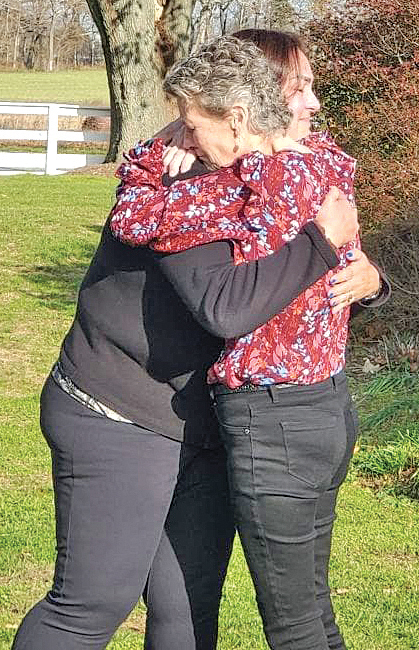Bone marrow match saved a local life; drive will now aim to help more

When Joanne Goerler was diagnosed with myelodysplastic syndrome, a blood cancer in which blood cells in the bone marrow do not mature, a doctor said her only option was to find a donor.
Three years later, Ms. Goerler, a teacher whose family owns Jamesport Vineyards, recalled a question her husband, Ron, asked that doctor.
“[He asked] about a second opinion, or about what would happen if we did nothing,” she said. “The doctor’s answer was clear: ‘She’s going to die.’ ”
Once Ms. Goerler was swabbed for the matching process, she waited for the registry to find a good match. After two months, some potential donors were identified. Thankfully, Beatrice Rodriguez of Massachusetts had registered for Be The Match, a national donor program, 22 years earlier.
“It’s bigger than ‘lucky,’ bigger than ‘fortunate.’ I would say it was ‘amazing,’ ” Ms. Goerler said, describing her reaction on learning that a donor match had been found for her. “It was very emotional.”
Especially impressive, the Cutchogue resident added, was that her donor, Ms. Rodriguez, had made the commitment 22 years earlier to see if her bone marrow could save another life. An immigrant from Brazil, she had taken part in a bone marrow drive seeking a match for a young girl. Although she wasn’t a match at that time, Ms. Rodriguez stepped up to keep her commitment when she learned that she was a match for Ms. Goerler.
“So many people offer to be a donor on impulse,” Ms. Goerler said, “then realize that they’re in a different place” when a recipient is found at a later time. “But she stood firm.”
At a minimum, donor and recipient need to have 10 markers that match; an additional two potential markers are less critical but desirable. “Beatrice and I matched on 11 of the 12 markers,” she said.
Ms. Rodriguez was visiting Brazil at the time so they had to wait a few months for her to return and then quarantine.

In addition to finding a donor, the treatment required Ms. Goerler to undergo chemotherapy for four or five months to prepare her blood. Once the transplant date was set, she underwent six days of intense chemotherapy in September 2019, followed by one day of rest and then the transplant, at Weill Cornell Medical Center in Manhattan.
Ms. Rodriguez, at the same time, received injections to stimulate cell growth. Her blood was centrifuged “to take out what they don’t want,” Ms. Goerler explained, and the remainder put back, in a six-hour process.
For Ms. Goerler, the transplant process took 11 minutes, with “a minute amount of a hot-pink-colored liquid.” Six weeks in isolation at the hospital followed, with monitoring as the undesirable numbers in her blood went down to zero. “I had to laugh,” she said, because aches in her legs reminded her of what people tell their children, “It’s just growing pains.” Her medical team explained that those pains were a good sign, meaning that the transplant was working.
Although the treatment was successful, the side effects were considerable. She’d been advised that because the donor was not a relative, the chances for a graft vs. host reaction were high. “Everything they said could happen did,” Ms. Goerler said, ranging from a rash to diabetes to a pulmonary embolism. But she endured, and when she reached the one-year mark after the transplant, there was plenty to celebrate.
An even more emotional high point came recently, when she and Ms. Rodriguez, who had connected only via phone and video, finally got to meet in person.
Ms. Rodriguez traveled via the Cross Sound Ferry to Ms. Goerler’s home , where they were surrounded by Ms. Goerler’s parents, Joe and Beanie Zuhoski of Cutchogue, siblings and extended family.
“Everyone welcomed her with open arms,” Ms. Goerler said of the emotional gathering among the vines of her family’s Jamesport Winery.
Beatrice Rodriguez was married but had no children; she likened the experience of being a donor to “making a life.”
When she later traveled again to Brazil, she and her mother chatted by video with Ms. Goerler, who recalled, “her mother called me her ‘baby daughter.’ ”
A drive for Joanne
In honor of Ms. Goerler, the East Hampton school community is hosting an outdoor “Swab for Life” bone marrow drive at John M. Marshall Elementary School on Saturday, June 5. Ms. Goerler has taught at the school for over 30 years.
Be The Match is inviting residents of East Hampton and the surrounding communities on both the North and South forks and Shelter Island to a drive-through, no-touch swabbing event. The June 5 drive will be held from noon to 4 p.m. in the parking lot of the school at 3 Gingerbread Lane in East Hampton.
Individuals ages 18 to 44 years are encouraged to attend the drive to become part of the Be The Match Registry and have the opportunity to save a life. Participants will be instructed to register from their mobile phones and will be given a quick, painless swab of the inner cheek. It only takes about 10 minutes to register. Registry members will only be called for further testing if they are identified as a potential match for a patient in need of a transplant.
For further information, contact Gina Kraus at 516-449-0829 or [email protected]; or Dr. Ron Jacobs, Be The Match, [email protected]








